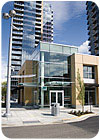
All of the high-rise condos in this Portland development feature a water loop heat pump heating and cooling system, with on-site boiler and cooling tower, which have helped the developers pursue LEED® certification.
When a building project becomes a cover story inUSA Today, you know there’s a story to be told. And that’s what happened last year when the newspaper turned its attention the South Waterfront condo/mixed-use complex just south of downtown Portland, OR.
The project is being built as an example of one of the largest green urban-redevelopment projects worldwide. Among the world’s most environmentally conscious locales, people in the city of Portland are doing their best to make a statement.
South Waterfront, still in the midst of major ongoing construction, is located on the west bank of the Willamette River. It’s a planned community of high-rise condominiums and shops, restaurants, theaters, and museums connected to downtown by Portland’s streetcar system.
Several high-rise condos are completed and occupied, and two other major condo developments are nearing completion. All of the buildings have at least one thing in common: each features a ClimateMaster water loop heat pump (WLHP) heating and cooling system, with on-site boiler and cooling tower.
ClimateMaster’s Tranquility energy-efficient equipment fits the need at South Waterfront because the developers there are pursuing LEED® Gold or Silver certifications for all of the structures.
Lower Average Energy Costs
The driving concept behind South Waterfront is to develop a fully environmentally sensitive “live/work” community to serve as an example of green commitment on a comparatively large scale. One of the most prominent benefits to residents and businesses at South Waterfront are substantially lower average energy costs. This is a result of the efficiencies designed into the WLHP systems incorporated into the basic layout of each of the condos.Design engineer Stacey Lin of Portland’s Bouillon Engineering LLC - the primary engineering firm on three of the four South Waterfront high-rise condo projects - said, “We use the water source heat pumps for three good reasons,” said Lin.
“First, energy efficiency. Secondly, these units are among the least obtrusive, acoustically,” he added. “The third benefit,” he continued, “is the option to use non-CFC compound, EarthPure HFC-410a, a non-ozone-depleting refrigerant.”
“We’re not at all surprised that the equipment was selected at least partially on a ‘noise-abatement’ basis,” added Kevin Marple, vice president of Benz Air Engineering Co. Inc., the Portland-based mechanical contracting firm tapped to do the equipment installations.
Beyond the noise factor, there’s the key challenge involved in designing systems to work in high-rise buildings. “It’s not so much a challenge for the water source heating and cooling system as it is for the domestic water supply,” said Lin. “As the building gets higher, obviously the static water-pressure conditions change.”
Then there’s the important question of how many heat pumps it takes to service a high-rise building that may include 300 residential units, plus retail establishments on the lower floors - all of varying sizes.
According to Marple, there are about 250 heat pump systems in the Meriwether complex, one of the condo developments. “There are 2-ton, 4-ton, and 5-ton units in both vertical and horizontal configurations. In each condo, the heat pump is located in the laundry/utility room for ease of access and maintenance by the owner or a technician,” said Marple. For each high-rise building, a heating and cooling capacity of 700 to 1,000 tons is needed.
Energy Transfer Brings Savings
“With our closed-loop system, building height doesn’t affect us that much,” said Lin. “You still have to provide the big building loop - with vertical pipes, basically, connecting all of the zones together.”“There are other reasons that water source heat pumps make a lot of sense,” Lin said. “We don’t have heat rejection within the living quarters. So we extract heat from the heat pump, or put it back in based on the need. We also have the ability to transfer energy. It’s not uncommon during the ‘swing’ temperature days for one side of the building to be in the heating mode while the other side is in cooling mode. With this mechanical system, thermal energy is moved from one side of the building to the other without having to add additional energy to the loop. Yet, the boiler and tower are in the ‘off’ mode. This saves a lot of energy.”
“During extreme days - whether heating or cooling - you have the means of adding heat through the gas-fired boilers or you take the heat out through the big cooling tower to cool down to the loop temperature,” he added.ES
